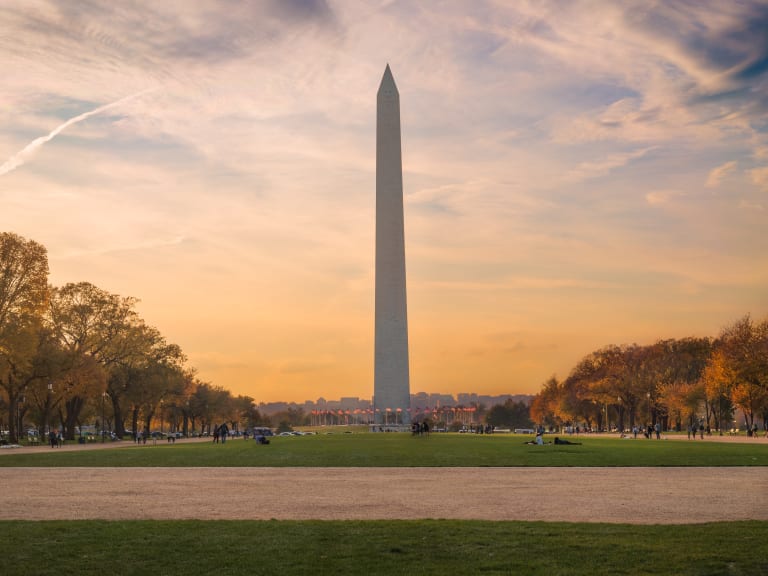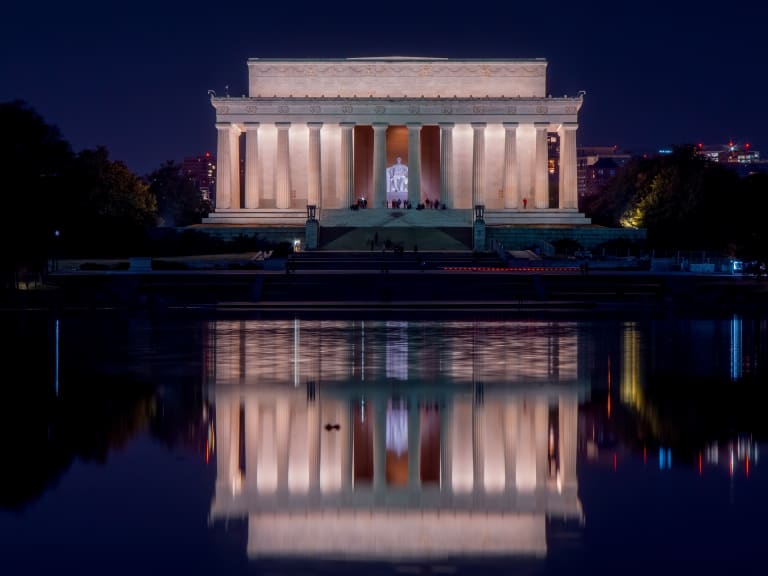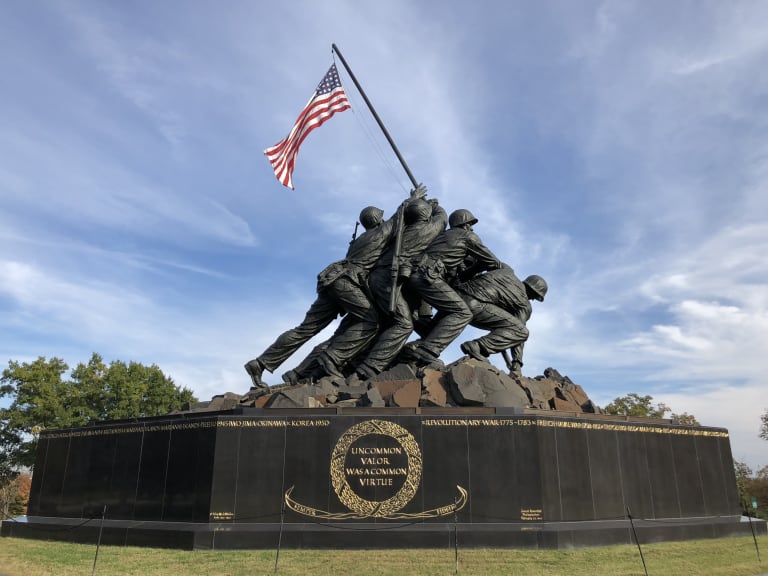10 Washington DC Best Monuments
The American capital is a planned city that stands out as the political centre of power but also pays homage to the country's history. From Lincoln to Jefferson and World War II to Vietnam, here are the best monuments to see on your visit to Washington.

Sunset at the World War II Memorial | ©John Brighenti
Since its founding in the late 18th century, Washington DC has become a historical and cultural landmark in the United States. On the banks of the Potomac River and named after George Washington, one of the founding fathers, it began to stand out as a seat of central power, but also for its architectural beauty and the beauty of its monuments.
Easily accessible from New York, Boston or virtually any city on the East Coast, there are many things to see in Washington such as the George Washington Obelisk, the Lincoln Memorial or more recent additions such as the Martin Luther King Memorial, one of the contemporary symbols of African-American culture. Read on to find out more about the best monuments in Washington DC.
1. Washington Obelisk

Built at the west end of the National Mall, the Obelisk is the symbol of the city that pays homage to its namesake. George Washington was the first president of the United States and one of the main heroes of American independence. The Obelisk that commemorates him took forty years to build but, at 169 metres and 14 centimetres tall, it was the tallest building in the world until Paris unveiled the Eiffel Tower in 1889.
Built of granite, steel and marble, its design was discussed and planned in detail to show the historical stature of the honoree. The Obelisk shape was chosen because it reflects sobriety and elegance, height and neatness, but also because it is a characteristic figure of Freemasonry and Washington was a Freemason. The reflecting pool that is aligned with the monument doubles its magnitude, and at night it offers an unmissable perspective.
Access to the Washington Monument as well as the walk on the National Mall is free, but tickets tend to sell out quickly and in high season you can reserve your spot in advance on the National Park Service Ticket website. Weather permitting, the Obelisk Terrace offers some of the most attractive panoramic views of Washington DC.
2. Vietnam Veterans Memorial

The memorial was unveiled in 1982 and consists of three parts. The Vietnam War Women's Memorial honours the women who served in Asia, most of them serving as nurses. The Three Soldiers Statue is a symbol of the plurality of veterans and reflects three young combatants, one Hispanic, one African-American and one Caucasian, carrying their rifles and dressed in the distinctive summer uniform used in Vietnam. And the Wall is a simple but powerful tribute that has carved in granite the names of the more than 58,000 soldiers who died or disappeared during the war.
The Vietnam War is one of the greatest wounds in American history and also the symbol of an era in which Washington DC became the centre of protests to end a conflict that lasted nearly twenty years.
This monument, which is free to enter but which it is advisable to visit with the assistance of a guide, is striking for its size and its simplicity, two characteristics that invite the visitor to reflect on what was one of the great tragedies of the 20th century for the United States.
3. Martin Luther King Memorial

Inaugurated in 2011, it is one of the newest monuments on the National Mall, but also one of the most visited, as it pays tribute to a leading figure in the struggle for Civil Rights in the 1960s.
Martin Luther King Jr. became a symbol of African-Americans very close to the Lincoln Memorial, just metres from where his figure now stands, when in 1963 he gave his famous "I have a Dream" speech, the text of which is engraved in the rock of the stone that serves as a tribute to him.
The memorial is the first to honour a man of colour in Washington DC and offers visitors a meandering tour through Martin Luther King Jr.'s most representative phrases, which are based on love, justice, democracy and hope, the four fundamental principles that the activist defended.
Access to the monument is free, and to learn more about King and his struggle you can also visit the Museum of African American History and Culture.
4. National World War II Memorial

Located at the far end of the Lincoln Memorial, and separated from it by the reflecting pool, is a tribute to American veterans of World War II. It is a national memorial that was completed in 2004 and was rushed through Congress so that all survivors of the war could have a living memorial.
This war memorial is one of the largest accessible on the National Mall and honours not only the veterans who fought on the front lines but all those who were part of the conflict, including those who served from the nation's armaments factories. That is why the design features 56 pillars topped with oak and wheat wreaths, symbolising industrial strength and agricultural production.
The park-like shape of the monument creates a wraparound perspective between the columns, and at night the illuminated fountain offers a full view of the Lincoln Memorial on one side and the Washington Obelisk on the other. With free admission, it's a must-see when visiting the US capital.
5. Abraham Lincoln Memorial

The Lincoln Memorial is, after George Washington's Obelisk, the most famous memorial in Washington DC, and also one of the most beautiful. Situated at the horizontal end of the National Mall, with its back to the Potomac River, it is an imposing building flanked by 36 Doric columns, each representing the 36 states recognised at the time of Lincoln's death.
Inside, the building includes a seated sculpture of Abraham Lincoln and, above the figure, fragments of his speeches carved in stone. The memorial not only pays tribute to one of the most iconic presidents in American history, but has also become the site of major mass events, such as the 1963 Martin Luther King Jr. demonstration in his fight for Civil Rights for African-Americans or the protests against the Vietnam War in the 1960s and 1970s.
Access to the memorial is free and open daily from 8 a.m. to midnight. From the steps of the building you can see the Washington Obelisk and its image in the reflecting pool.
6. Ulysses S. Grant Memorial

Without the magnificence of George Washington or Abraham Lincoln, Ulysses S. Grant was an outstanding U.S. president who fought corruption and the Ku Klux Klan, but his most significant contribution was during the Civil War, as Commanding General of the Union Army. For his military activity, he washonoured with a memorial in front of the Capitol, a figure that shows Grant on a horse, extolling his virtues as a leader and horseman.
The monument, built tall, offers an open view of the Washington Obelisk and is the most important of the American Civil War memorials built in Washington.
As an open memorial you can visit it for free, but you can also opt for a tour with a guide who will tell you the history of this monument and the others dedicated to the heroes of the Civil War.
7. Albert Einstein Memorial

This memorial is very close to the Vietnam Veterans Memorial, located in front of the National Academy of Sciences. It was erected in 1979 to commemorate the 100th anniversary of Albert Einstein's birth.
The monument is made of emerald-coloured granite and is striking for its large size and the annotations on the papers that the sculpture holds in its hands. In them you can see some of the scientific advances that led to Einstein's research, such as the theory of relativity, the equivalence of energy and matter and the photoelectric effect, work for which he was awarded the Nobel Prize for Physics in 1921.
It is also a free access monument, and as it has no partition, it is possible to take photographs from very close to the sculpture.
8. Thomas Jefferson Memorial

This is one of the most beautiful memorials in Washington DC, but as it is located on the side of the National Mall, off the main drag, it can often go unnoticed by visitors or be mistaken for a government building when seen from afar. The truth is that inside the neoclassical building is a sculpture of Thomas Jefferson, one of the Founding Fathers of the United States, third president of the country and one of the promoters of the Declaration of Independence.
The view of the memorial from the National Mall is very interesting, especially when night falls and the lights of the memorial also illuminate the Tidal Basin, the man-made inlet along the Potomac River.
The memorial is free to enter, and although it has been perceived in popular culture as a low-turnout memorial due to its location, it is one of the other sites Washington DC has to offer.
9. Franklin Delano Roosevelt Memorial

Located very close to the Thomas Jefferson Memorial, it not only honours the last U.S. president to serve more than two consecutive terms in office, but also bears witness to an entire era. The massive monument traces twelve years of American history and honours Franklin Delano Roosevelt in his wheelchair as well as his wife and all the American workers who had to endure the Great Depression.
The most recommended part of the monument is the artificial waterfall that is divided into four parts, representing each of his four terms in office, and whose waters become untamed as the tour progresses, a clear demonstration of the uphill struggle Roosevelt had to go through during his administration, which began with the Economic Crash of 1929 and ended with World War II.
It is also a free monument and I recommend that you take advantage of the adjacent circuit to visit the Martin Luther King Memorial and the Thomas Jefferson Memorial, as well as the National Mall through the Tidal Basin.
10. Iwo Jima Memorial

This monument represents the triumph at the Battle of Iwo Jima against the Japanese army during World War II, but it is also a tribute to all the fallen of the United States Marine Corps since they entered service in 1775. The sculpture is also a faithful copy of Joe Rosenthal's photo of the soldiers raising the American flag - an image that became famous aroundthe world.
The Iwo Jima Memorial is located across the Potomac River from the National Mall, but geographically it is not in Washington but in Virginia, and is located at the entrance to Arlington National Cemetery.
Access to this monument is free and I recommend you also visit the cemetery, which is where veterans of all wars since American Independence are buried. The cemetery is also home to the tomb of John F. Kennedy and the tomb of the unknown soldier, which pays tribute to all those soldiers who could not be recognised or were missing in battle and has permanent custody.
11. Korean War Veterans Memorial

Located next to the Lincoln Memorial, this is one of the most striking monuments on the National Mall. It is shaped like a triangle with 19 steel statues representing a squadron patrolling over a winding terrain, much like in Korea.
The statues are flanked by a granite wall carved with the words "Freedom is not free" and detailing the number of US and UN casualtiesin the conflict.
and the United Nations in the conflict.
The memorial is free to visit and offers an expansive view of the Vietnam Veterans Memorial, which is immediately opposite on the other side of the reflecting pool. I recommend visiting this memorial and then continuing on to the Martin Luther King Jr. Memorial and the World War II Veterans Memorial.
12. The White House, Capitol and Supreme Court

While not monuments, your visit to Washington DC is not complete until you visit these landmark buildings of the branches of the federal government. The White House is located next to the Washington Obelisk and is the official residence of the President of the United States. It is free to visit, although it must be booked in advance and is not always open to the public.
The Capitol, located at the opposite end of the National Mall from the Lincoln Memorial, is the building that houses the US Congress. It is known for its central dome and the two wings on either side that house the Senate and the House of Representatives. It is free to visit and has galleries on the upper floors for visitors to observe sessions.
The Temple of Justice, as the U.S. Supreme Court building is known, is located behind the Capitol and is the seat of the country's judicial branch. It is a lavish construction that was completed in 1935 and has a Romanesque style, resembling the Pantheon. Its interiors are built in marble from different states and has a spiral staircase leading to the top of the building. The most recommended sight to see is the tribunal, which has four pink marble columns that were imported from Italy.
The visit is free but it is necessary to keep to the schedule as the building is closed to the public during the judges' conference days.
